|
Advantech PCM-C3500 Series
RISC Single Board Computer based on the TI OMAP35 series of processors
(by Conrad H. Blickenstorfer)
There was a time not too very long ago when the RISC versus CISC processor debate was headline material in IT publications everywhere. CISC, of course, stands for Complex Instruction Set Computer, and RISC for Reduced Instruction Set Computer. CISC processors are complex and use complex instructions to perform complex operations in one single step. RISC processors, on the other hand, are much simpler and break operations down into a number of basic steps. At the time, RISC supporters felt that RISC chips represented a simpler, less costly, and more economical way of computing. All this happened around the era where RISC-based UNIX machine began replacing older superminis, and SUN Microsystems pushed its SPARC (Scalable Processor ARChitecture) with such catchy slogans as "SPARC rules the desktop" (it didn't).
As it turned out, SPARC didn't, and RISC lost to CISC, which was championed by Intel. For the past 25 years or so, Intel pretty much dominated the desktop, notebook and server market, i.e. the most visible part of computing. RISC, however, never went away. It simply retreated to different markets, mostly mobile and low-power embedded systems. Now the debate is heating up again, with hundreds of millions of ever more powerful smartphones and now tablets running on RISC processors, mostly ARM-based designs (ARM vs. Intel was actually a hot topic in the early 90s). ARM stands for Advanced RISC Machine and ARM-based chips can drive even devices as complex as an iPad for many hours without needing a fan or heating up at all.
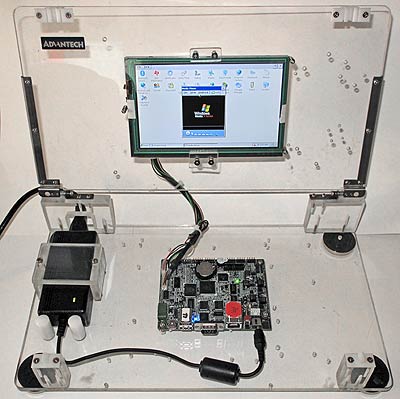 Why do I mention all of the above? Because we're starting to see more ARM designs in a number of markets again, and not just in smartphones and tablets. Even Microsoft vowed to support ARM in the next major rev of Windows, albeit only in "Metro" mode and not "classic." So a recent news release by Advantech caught our eyes, the company's announcement of a TI OMAP35 Series-based RISC Single Board Computer, the PCM-C3500. Why do I mention all of the above? Because we're starting to see more ARM designs in a number of markets again, and not just in smartphones and tablets. Even Microsoft vowed to support ARM in the next major rev of Windows, albeit only in "Metro" mode and not "classic." So a recent news release by Advantech caught our eyes, the company's announcement of a TI OMAP35 Series-based RISC Single Board Computer, the PCM-C3500.
We asked Advantech if we could take a look at the board, and they were kind enough to send us their PCM-C3530 off-the-shelf evaluation kit that provides a complete design environment with full tech documentation.
The kit, shown in the picture to the right, includes an OS-ready (ours came with Windows CE 6.0) RISC-based COM/SBC, an 800 x 480 pixel 7-inch LCD kit with a resistive touchscreen, power supply, test cables, an accessory package, and a CD-ROM with system upgrade/maintenance utilities, SDK, system test utility, user manual, and COM design guide. Ours was an eval system that was mounted in a nicely crafted acrylic demo stand. The idea here is to provide developers and system integrators with a full test system as well as a good deal of additional handholding and support: Advantech also offers an application-oriented support package, complete with testing and evaluation capabilities, to minimize solutions development efforts.
What makes the PCM-C3550 attractive and who should take a look at it?
- The system can run Windows CE, Linux and even Android.
- There's no need for a fan or even heat sink.
- The board uses just 2 watts; the whole system with a 5 or 7-inch screen less than 7 watts.
- There is support for OpenGL ES (1.1 and 2.0), OpenVG 1.0, and Direct 3D (3530-based models)
- Availability of Advantech's SUSIAccess (a set of software APIs)
- Guaranteed long product life-cycle (up to 7 years)
- If needed, there is extended temperature range support (up to -40° to 185°F)
Given the current uncertainty surrounding mobile and embedded operating systems, the ability to have a variety of supported OS options is priceless. Android, especially, is of considerable interest to many developers, and having the option to look into Android in a flexible, industrial-strength hardware platform with extensive industry standard interface support is very attractive indeed.
What applications come to mind? Since there's no heat sink and the system uses so little power, the PCM-C3500 is suitable for all sorts of portable applications. Industrial control is a candidate, as well as all sorts of HMI (human-machine interaction) systems, kiosks, self-service, data collection, or medical applications.
The TI OMAP 35 Series
Why did Advantech choose the TI OMAP 35 Series of processors for the PCM-C3500? Probably because it's a competent, mature line of System on Chip (SoC) designs from a highly regarded company. OMAP stands for Open Multimedia Application Platform, a name that clearly communicates what Texas Instruments designed these chips for. 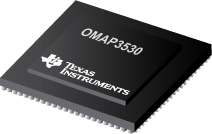 OMAP SoCs are using general-purposes ARM processor cores, but usually also include more specialized co-processors. OMAP SoCs are using general-purposes ARM processor cores, but usually also include more specialized co-processors.
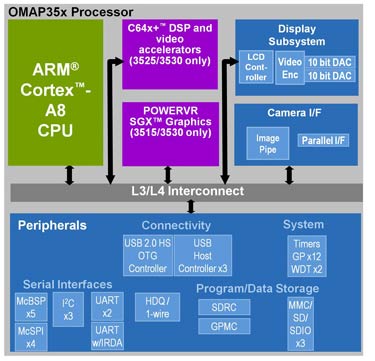 The two chips available with the PCM-C3500 are the OMAP3503 and the OMAP3530. Both have a 600MHz ARM Cortex A8 processor with 2D/3D graphics acceleration through a NEON co-processor. The primary difference between the two available chips is that the 3530 has a PowerVR SGX GPU whereas the 3503 doesn't. So if OpenGL (see Wiki on OpenGL), OpenVG (see Wiki on OpenVG), or Direct3D are needed, that requires the OMAP 3530-based version of the PCM-C3500. The two chips available with the PCM-C3500 are the OMAP3503 and the OMAP3530. Both have a 600MHz ARM Cortex A8 processor with 2D/3D graphics acceleration through a NEON co-processor. The primary difference between the two available chips is that the 3530 has a PowerVR SGX GPU whereas the 3503 doesn't. So if OpenGL (see Wiki on OpenGL), OpenVG (see Wiki on OpenVG), or Direct3D are needed, that requires the OMAP 3530-based version of the PCM-C3500.
OpenGL (Open Graphics Library), especially, may be of interest to developers, or may be a requirement with many customers. It defines a cross-language, cross-platform API for high-performance 2D and 3D computer graphics. Going back to the early 1990s when Silicon Graphics first introduced it, OGL remains very popular. It provides similar functionality to Microsoft's Direct3D, though with a very different approach.
For more detail on the Texas Instruments OMAP35xx Series, check TI's product page here.
The Advantech PCM-C3500 Series
The PCM-C3500 Series is implemented as a small Single Board Computer with a rectangular PCB measuring 120 x 90 mm, just a bit smaller than COM Express (which measures 125 x 95 mm). Below you can see the top (left) and bottom (right) of the PCM-C3530.
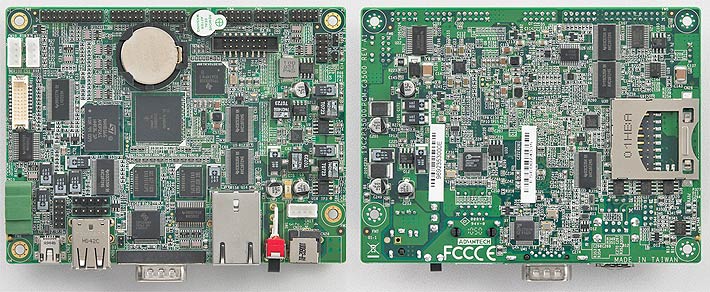
The picture below shows the PCM-C3530's edge connector face with, from left to right, an OTG (on-the-go) mini-USB port, two standard USB 2.0 ports, a standard DB9 serial port, an Ethernet 10/100 RJ45 LAN jack, the on-off switch, and the power jack.

Above I mentioned the difference in the OMAP3503 and 3530 processors used in the two versions of the PCM-C3500 Series. There are some other differences as well:
1) The 3530-based model has 2GB of onboard Flash to boot from whereas the 3503-based model does not have any Flash and boots from an SD Card.
2) The 3530 model has significantly more serial connectivity. There's the standard DB9 RS232 connector, two additional RS232 ports via pin headers, a separate RS485 port with a special terminal block, and also a TTL port via pin header. The 3503 version does not have the DB9 connector, and also does not have the RS485 terminal block.
Note that most of the PCM-C3500 interface and connectivity functionality is accessible via pin headers. That includes pin headers for two I2C bus ports, a SPI (serial peripheral interface) bus, a 6 x 6 keypad, audio, GPIO, and several others. The supplied audio cable even comes with two chiclet-sized speakers.
Software
Below are some screen grabs off the PCM-C3500. Onboard graphics can support 640 x 480, 800 x 480, 800 x 600, or even 1024 x 768. Our test system ran 800 x 480 pixel on the 7-inch display, making for nice, sharp text that was neither too large nor too small. On the top left is the desktop with the OMAP logo, on the top right a demo graphics interface that shows that Windows CE doesn't have to look basic. The bottom left shows the Control Panel screen with all of its utilities. On the bottom right is a Windows Command console with a small pop-up keyboard.
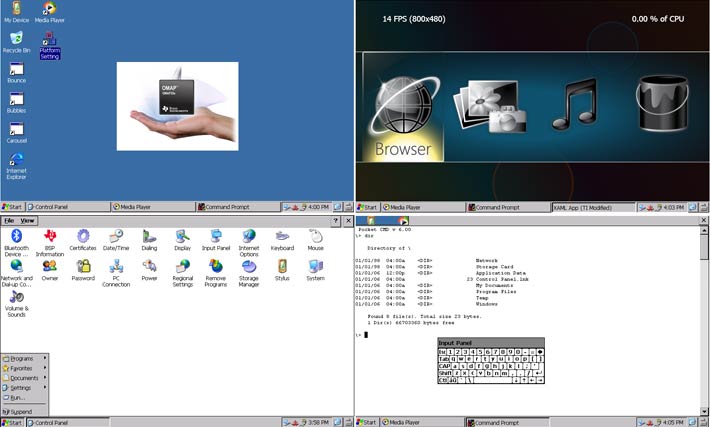
The screens below are different tabs from Advantech's very useful "Platform Setting" utility. It allows for easy lookup of system settings, as well as configuring the system.
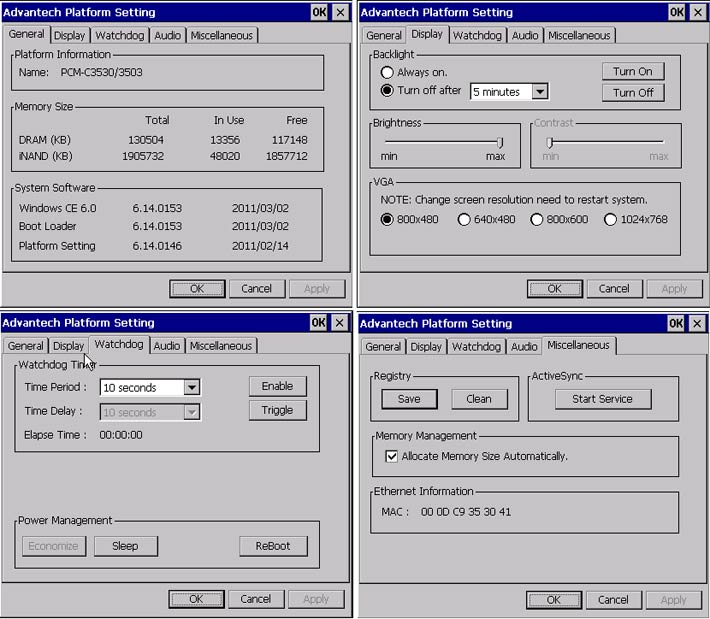
Below is a schematic of the Advantech PCM-C3500:
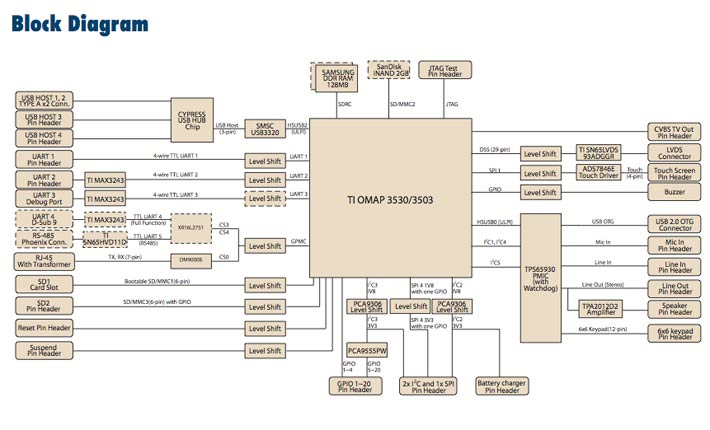
With the PCM-C3500 Series of single board computers, Advantech further expands its already vast range of computing modules and systems available in numerous standards. It also expands its roster of RISC-based systems, a product line that may well grow in importance over the next few years. -- Conrad H. Blickenstorfer, October 2011
Advantech PCM-C3500 Series Specs:
| Type |
Single Board Computer
|
| CPU Type |
Texas Instruments OMAP 3503 or 3530 Cortex-A8
|
| Clock Speed |
600 MHz
|
| Chipset/DSP |
Built-in 430 MHz TMS320C64x+ DSP Core support (3530 only)
|
| BIOS |
unknown
|
| OS |
Embedded Linux2.6, Windows CE 6.0, Android
|
| Memory |
PCM-C3530: 256MB mobile DDR + 2GB onboard Flash
PCM-C3503: 128MB mobile DDR; boot from SD Card
|
| Graphics Controller |
CPU internal 24-bit LCD controller |
| VRAM |
unknown
|
| LVDS |
24-bit LVDS LCD connector
|
| HDMI |
NA
|
| Dual display |
NA
|
| LAN |
10/100BASE-T (RJ-45) |
| SATA |
NA |
| Expansion |
1 x SD slot, 1 x SD pin header
|
| Cfast |
NA
|
| SMBUS |
NA
|
| I2C |
2 x I2C (pin header)
|
| SPI |
1 x SPI (Serial Peripheral Interface, pin header)
|
| SSD |
NA
|
| USB |
4 x USB 2.0 ( 2 x Type A, 2 x pin header)
|
| USB OTG |
1 x USB HS OTG (OTG connector)
|
| Serial |
PCM-C3530: 3 x RS232 (1 x DB-9, 2 x pin header), 1 x RS-485 (box header), 1 x TTL (pin header)
PCM-3503: 2 x RS232 (pin header), 1 x TTL (pin header)
|
| Parallel |
NA |
| Audio |
MIC-in, Line-in, Line-out, Speaker-out (pin header) |
| GPIO |
20 pins 3.3V TTL level GPIOs (pin header) |
| Watchdog Timer |
Yes
|
| Size |
120 mm x 90 mm (4.75" x 3.45")
|
| Weight |
3.25 oz (92 grams lb), weight of board |
| Power |
10 to 24 VDC
|
| Power draw |
Standard 2 watts (max. 3 watts)
|
| Operating Temp. |
32° to 140°F (0° to 60°C); optional wide-range support -40° to 185°F (-40° to 85°C)
|
| Price |
inquire
|
| Datasheet |
Advantech PCM-C3500 |
| User Manual |
Advantech PCM-C3500 Series Eval. Lit manual |
Advantech Corporation
38 Tesla, Suite 100
Irvine, CA 92618
Toll Free: 1-800-866-6008
Ph: 949-789-7178
Fax: 949-789-7179
ECGInfo@advantech.com
www.advantech.com
Advantech Co. Ltd.
No.1, Alley 20, Lane 26, Rueiguang Road
Neihu District, Taipei Taiwan 114, R.O.C.
Tel: 886-2-2792-7818
Fax: 886-2-2794-7301
www.advantech.com
|



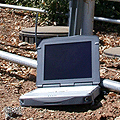

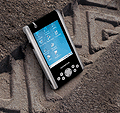
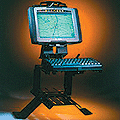





 Why do I mention all of the above? Because we're starting to see more ARM designs in a number of markets again, and not just in smartphones and tablets. Even Microsoft vowed to support ARM in the next major rev of Windows, albeit only in "Metro" mode and not "classic." So a recent news release by Advantech caught our eyes, the company's announcement of a TI OMAP35 Series-based RISC Single Board Computer, the PCM-C3500.
Why do I mention all of the above? Because we're starting to see more ARM designs in a number of markets again, and not just in smartphones and tablets. Even Microsoft vowed to support ARM in the next major rev of Windows, albeit only in "Metro" mode and not "classic." So a recent news release by Advantech caught our eyes, the company's announcement of a TI OMAP35 Series-based RISC Single Board Computer, the PCM-C3500.
 OMAP SoCs are using general-purposes ARM processor cores, but usually also include more specialized co-processors.
OMAP SoCs are using general-purposes ARM processor cores, but usually also include more specialized co-processors.
 The two chips available with the PCM-C3500 are the OMAP3503 and the OMAP3530. Both have a 600MHz ARM Cortex A8 processor with 2D/3D graphics acceleration through a NEON co-processor. The primary difference between the two available chips is that the 3530 has a PowerVR SGX GPU whereas the 3503 doesn't. So if OpenGL (
The two chips available with the PCM-C3500 are the OMAP3503 and the OMAP3530. Both have a 600MHz ARM Cortex A8 processor with 2D/3D graphics acceleration through a NEON co-processor. The primary difference between the two available chips is that the 3530 has a PowerVR SGX GPU whereas the 3503 doesn't. So if OpenGL (



